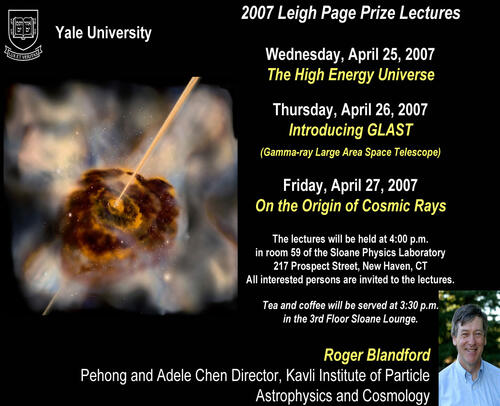
The Yale Physics 2007 Leigh Page Prize Lectures were given April 25-27, 2007 by Professor Roger Blandford the Pehong and Adele Chen Director, Kavli Institute of Particle Astrophysics and Cosmology.
Wednesday, April 25, 2007 - The High Energy Universe
When we look at the sky with our eyes, we mainly see stars, like our sun, either singly in our Galaxy or collectively in other galaxies. However when we observe with radio, X-ray or gamma-ray telescopes, we see a very different universe inhabited by electrons and protons, moving with speeds near to that of light, energized by black holes, neutron stars and white dwarfs. Understanding these high energy sources can teach us about fundamental physics in action in extreme environments that we cannot create on Earth. In this talk, I will outline how astronomers make observations throughout the electromagnetic spectrum and explain some recent observations of quasars, pulsars, gamma ray bursts and supernova explosions in these terms.
Thursday, April 26, 2007 - introducing GLAST (Gamma-ray Large Area Space Telescope)
The Gamma-ray Large Area Space Telescope is an international space observatory scheduled for launch in November. It will detect high energy gamma rays from the whole sky with an effective sensitivity roughly fifty time that of earlier telescopes. It was designed and constructed using technology that had been developed for use at particle accelerators. It should greatly improve our understanding of how relativistic jets are formed in the nuclei of active galaxies of how pulsars create intense pulses of high energy particles, of how black holes and neutron stars are formed in supernovae explosions and of how cosmic rays, with energies that can be as large as that of a well-hit baseball, are created.
Friday, April 27, 2007 - On the Origin of Cosmic Rays
It is ninety five years since Victor Hess showed that cosmic rays have an extraterrestrial origin. We now know that cosmic rays with energies well below a GeV come mostly from the heliosphere, that those with energies up to about a PeV are accelerated within the galaxy, predominantly in supernova remnants, and that the highest energy particles - up to a ZeV in energy - are extragalactic. However, the detailed mechanisms responsible for particle acceleration are not well understood. In this talk, I will explain some general principles that operate and specialize to describe recent observational and theoretical developments in our understanding of how strong, astrophysical shock waves boost protons and electrons to enormous energy and amplify magnetic fields.
The Leigh Page Prize Lecture series are given each year by a distinguished physicist in honor of Leigh Page who received his PhD in Physics from Yale in 1913. He was later acting Chair and Director of the Sloane Physics Laboratory. Professor Page devoted his time to teaching (mostly graduate classes), research, and writing several textbooks. Since 1967, several speakers in the Leigh Page Prize Lecture series have later received Nobel Prizes and other notable awards. In connection with the lecture series, a prize is offered to first year graduate students in recognition of their fine academic record and for the promise of important contributions to the field of physics.